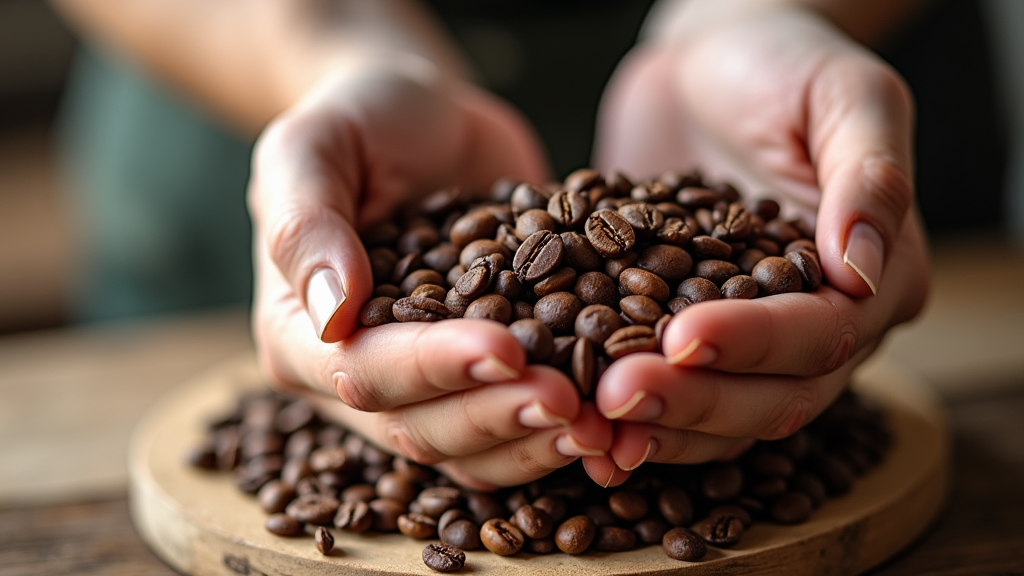Table of Contents
- Understanding How Freeze Dried Coffee Is Made Outline
- Understanding How Freeze Dried Coffee is Made Outline
- Detailed Guide: How Freeze Dried Coffee is Made Outline
Understanding How Freeze Dried Coffee Is Made Outline

**Pro Tip:** To maximize flavor when using freeze-dried coffee, use water just off the boil (around 200°F or 93°C) for reconstitution. Experiment with adding freeze-dried coffee directly to recipes for a concentrated flavor boost without extra liquid.
Freeze Dried Coffee: An Overview and Market Importance
Freeze-dried coffee offers a convenient and flavorful alternative to traditional brewing methods. Its unique process effectively preserves the coffee’s aroma and taste, making it a popular choice for many.
The global freeze-dried coffee market is estimated at $[Insert Market Size] in [Insert Year] and is expected to reach $[Projected Market Size] by [Projected Year], showing a CAGR of [Projected CAGR]%. This growth highlights its increasing significance in the coffee industry.
This matters because freeze-dried coffee provides a quick and easy way to enjoy a cup of coffee without sacrificing flavor quality. It’s particularly well-suited for travel, camping, busy lifestyles, and situations where convenience is key. Additionally, it boasts a longer shelf life compared to regular coffee beans or ground coffee.
Historical Background of Freeze Dried Coffee Production
Freeze-drying technology was initially developed in the mid-20th century as a method for preserving food for military rations. Recognizing its potential, the process was adapted for coffee to create a convenient and shelf-stable product.
Recent advancements in freeze-drying technology have significantly improved flavor retention and aroma. This, coupled with increased consumer demand for convenient and high-quality coffee options, has fueled the growth of the freeze-dried coffee market. Furthermore, there’s a growing availability of organic and sustainably sourced freeze-dried coffee, catering to environmentally conscious consumers.
Key Learning Objectives: Freeze Dried Coffee Outline
By the end of this guide, you will understand the core principles of the freeze-drying process and how it impacts the flavor of coffee. You’ll also be able to differentiate freeze-dried coffee from other types of instant coffee.
Furthermore, you’ll learn practical applications, such as how to properly reconstitute freeze-dried coffee to achieve the best possible taste. We’ll also explore various uses of freeze-dried coffee in different recipes and beverages, expanding your appreciation for this versatile product.
Understanding How Freeze Dried Coffee is Made Outline
Fundamental Concepts in Freeze Dried Coffee Outline
**Option 1 (Focus on Flavor):**
> To maximize flavor, consider the bean selection and roasting level. Arabica beans offer a smoother, more aromatic profile, while light roasts retain more acidity and delicate flavors that can be lost with darker roasts.
**Option 2 (Focus on the Process):**
> The freeze-drying process hinges on precise control of temperature and pressure; a freezing temperature of around -40°C and low vacuum pressure are crucial for efficient sublimation and preserving the coffee’s quality.
**Option 3 (Focus on Consumer Choice):**
> When choosing freeze-dried coffee, consider granule size, as this impacts dissolution rate, and opt for airtight packaging to ensure freshness; also, remember that caffeine content remains consistent with traditionally brewed coffee.
Freeze-drying, also known as lyophilization, is a dehydration process crucial to creating freeze dried coffee. It involves removing water from frozen coffee by placing it under a vacuum, allowing the ice to transition directly from a solid to a vapor, bypassing the liquid phase. This process is called sublimation.
Reconstitution is the final step for the consumer, where water is added back to the dehydrated coffee, returning it to a drinkable state.
- Freeze-drying (Lyophilization):A dehydration process that removes water from a product after it is frozen, placing the product under a vacuum, allowing the ice to change directly from a solid to a vapor without passing through a liquid phase.
- Sublimation:The process of a substance transitioning directly from a solid to a gas state.
- Reconstitution:The process of adding water back to a dehydrated substance to return it to its original state.
The core principles involve freezing the coffee to preserve its structure and flavor, applying a vacuum to facilitate sublimation, and collecting the water vapor to leave behind dry coffee granules.
Essential Components for Freeze Dried Coffee Production Outline
Producing freeze dried coffee requires several key components. High-quality roasted coffee beans, whether Arabica or Robusta, are essential. Commercial brewing equipment is needed to create a strong coffee extract. A freeze-drying machine, typically industrial-scale, is necessary to perform the lyophilization process. This machine includes a vacuum chamber and condenser coils. Finally, airtight packaging is crucial for preserving the quality of the final product.
- High-quality roasted coffee beans (Arabica or Robusta).
- Brewing equipment (commercial coffee maker).
- Freeze-drying machine (industrial scale).
- Vacuum chamber.
- Condenser coils.
- Airtight packaging.
Key Features to Consider in Coffee Freeze Drying Outline
Several factors influence the quality of freeze dried coffee. Bean selection is critical; Arabica beans offer smoother, more aromatic profiles, while Robusta beans provide bolder flavors. The roasting level also plays a role, with light roasts retaining more acidity and delicate flavors, and dark roasts providing a more intense taste. The freezing temperature, typically around -40°C (-40°F), ensures rapid freezing and minimal ice crystal formation.
- Bean Selection:Arabica beans offer smoother, more aromatic profiles, while Robusta beans provide bolder, more robust flavors.
- Roasting Level:Light roasts retain more acidity and delicate flavors; dark roasts provide a bolder, more intense taste.
- Freezing Temperature:Typically around -40°C (-40°F) to ensure rapid freezing and minimal ice crystal formation.
Low vacuum pressure (e.g., 6.11 mbar) is essential for efficient sublimation. Drying time varies depending on the equipment and batch size, ranging from 12 to 36 hours. The packaging material must be airtight and moisture-resistant to maintain freshness. The granule size can range from fine powder to larger crystals, affecting dissolution rate. The caffeine content remains the same as the original brewed coffee. Organic options are available for consumers seeking sustainably sourced coffee.
- Vacuum Pressure:Low pressure (e.g., 6.11 mbar) is essential for efficient sublimation.
- Drying Time:Varies depending on the equipment and batch size but can range from 12 to 36 hours.
- Packaging Material:Must be airtight and moisture-resistant to maintain freshness and prevent degradation.
- Granule Size:Can range from fine powder to larger crystals, affecting dissolution rate.
- Caffeine Content:Remains the same as the original brewed coffee.
- Organic vs. Conventional:Organic options are available for consumers seeking sustainably sourced coffee.
Detailed Guide: How Freeze Dried Coffee is Made Outline

**Key Takeaway:** Crafting exceptional freeze-dried coffee hinges on meticulous preparation and precise execution. Using high-quality beans, optimizing the freezing process to prevent large ice crystals, and ensuring complete dryness before airtight packaging are crucial for preserving flavor and extending shelf life.
Preparation: Materials for Freeze Dried Coffee Outline
Creating high-quality freeze dried coffee requires specific materials and careful preparation. The key ingredients and equipment include:
- Roasted coffee beans (Arabica, Robusta, or blends) to define the flavor profile.
- Commercial coffee brewing equipment for consistent extraction.
- An industrial freeze-drying machine to perform the sublimation process.
- Airtight packaging containers (foil pouches, glass jars) to maintain freshness.
Before starting, ensure the freeze-drying machine is clean and calibrated. Prepare a concentrated coffee brew with a Total Dissolved Solids (TDS) level between 10-12%. Pre-freeze the coffee extract to approximately -40°C (-40°F) in trays or on belts.
Maintaining consistent coffee bean quality and roasting profiles is crucial. Also, ensure proper brewing parameters to achieve optimal flavor extraction. Rapid freezing prevents large ice crystal formation, which can damage the coffee structure.
Step-by-Step: Freeze Dried Coffee Production Outline
Follow these steps to produce freeze dried coffee:
Best practices include using high-quality coffee beans and monitoring temperature and pressure during freeze-drying. Ensure the coffee is completely dry before packaging.
Avoid using low-quality coffee beans, inadequate freezing, and insufficient drying. These mistakes can lead to a bland taste, damaged coffee structure, and reduced shelf life.
Advanced Techniques: Optimizing Freeze Dried Coffee Outline
Enhance your freeze dried coffee with these expert tips:
- Experiment with different coffee bean blends and roasting profiles to create unique flavor profiles.
- Consider using a two-stage drying process to further reduce moisture content and improve shelf life.
- Add natural antioxidants or flavor enhancers to enhance the aroma and taste of the freeze-dried coffee.
Optimize the freezing rate and temperature to minimize ice crystal formation. Fine-tune the vacuum pressure and drying time to achieve optimal sublimation. Implement quality control measures to ensure consistent product quality.
Troubleshooting common issues:
- Problem:Coffee is not drying properly.
- Problem:Coffee has a bitter taste.
- Problem:Coffee is absorbing moisture after packaging.
- Solution:Check the vacuum pressure and condenser coil temperature. Ensure the freeze-drying machine is properly calibrated.
- Solution:Use higher-quality coffee beans or adjust the roasting profile.
- Solution:Ensure the packaging is airtight and moisture-resistant. Consider adding a desiccant packet to absorb any residual moisture.

